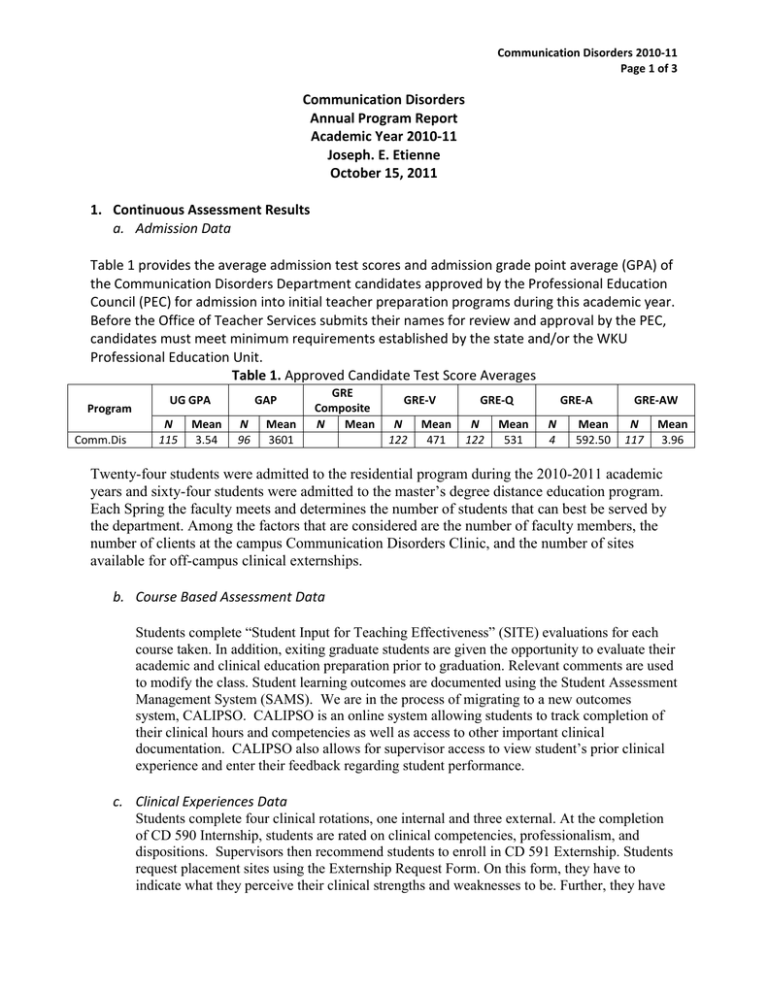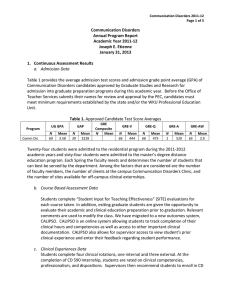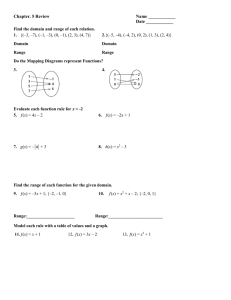Communication Disorders Annual Program Report Academic Year 2010-11
advertisement

Communication Disorders 2010-11 Page 1 of 3 Communication Disorders Annual Program Report Academic Year 2010-11 Joseph. E. Etienne October 15, 2011 1. Continuous Assessment Results a. Admission Data Table 1 provides the average admission test scores and admission grade point average (GPA) of the Communication Disorders Department candidates approved by the Professional Education Council (PEC) for admission into initial teacher preparation programs during this academic year. Before the Office of Teacher Services submits their names for review and approval by the PEC, candidates must meet minimum requirements established by the state and/or the WKU Professional Education Unit. Table 1. Approved Candidate Test Score Averages Program Comm.Dis UG GPA N 115 Mean 3.54 GAP N 96 Mean 3601 GRE Composite N Mean GRE-V N 122 Mean 471 GRE-Q N 122 Mean 531 GRE-A N 4 Mean 592.50 GRE-AW N 117 Mean 3.96 Twenty-four students were admitted to the residential program during the 2010-2011 academic years and sixty-four students were admitted to the master’s degree distance education program. Each Spring the faculty meets and determines the number of students that can best be served by the department. Among the factors that are considered are the number of faculty members, the number of clients at the campus Communication Disorders Clinic, and the number of sites available for off-campus clinical externships. b. Course Based Assessment Data Students complete “Student Input for Teaching Effectiveness” (SITE) evaluations for each course taken. In addition, exiting graduate students are given the opportunity to evaluate their academic and clinical education preparation prior to graduation. Relevant comments are used to modify the class. Student learning outcomes are documented using the Student Assessment Management System (SAMS). We are in the process of migrating to a new outcomes system, CALIPSO. CALIPSO is an online system allowing students to track completion of their clinical hours and competencies as well as access to other important clinical documentation. CALIPSO also allows for supervisor access to view student’s prior clinical experience and enter their feedback regarding student performance. c. Clinical Experiences Data Students complete four clinical rotations, one internal and three external. At the completion of CD 590 Internship, students are rated on clinical competencies, professionalism, and dispositions. Supervisors then recommend students to enroll in CD 591 Externship. Students request placement sites using the Externship Request Form. On this form, they have to indicate what they perceive their clinical strengths and weaknesses to be. Further, they have Communication Disorders 2010-11 Page 2 of 3 to indicate how a placement at the desired site(s) will help them develop the needed competencies. The Externship Coordinator reviews this form, any previous clinical evaluations and academic course work along with any requirements for the potential clinical site prior to the placement decision being made. If the requested site and supervisor have been used before, and a student evaluation of site and supervisor is available, the Externship Coordinator reviews those data prior to making a final decision about placement. At the end of each placement, students will prepare a reflective statement that summarizes their accomplishments during the placement. At that time, the students complete an evaluation of the site and an evaluation of the supervisor. That information is used to help plan future placements. d. Culminating Assessment Data To ensure that our graduates have the competency to meet the needs of all clients, a passing score on the Praxis II (Speech-Language Pathology) must be submitted before graduation. If a student does not pass the Praxis, then written comprehensive examinations are mandatory. A reflective statement is submitted by each graduate student. This statement regarding their goals and experiences in clinical externships is intended to demonstrate ability to assess, treat, and reflect upon a clinical case. e. Exit and Follow Up Data Following reconfiguration of course offerings, students now report being better prepared int heir clinical placements with adults. In anticipation of teacher admission requirement changes (as approved by the Education Professional Standards Board), the department will examine its admission requirements to better align with the teacher admission requirements which begin September 1, 2012. While examining requirements, the department will also modify its requirements to reflect proposed ASHA (American Speech Language and Hearing Association) guidelines which take effect January 1, 2014. 2. Summary of Results by Kentucky Teacher Standards and Other Key Conceptual Framework Values Students have to demonstrate competency in evaluation and treatment in nine clinical areas across the lifespan to meeting the certification standards of the American Speech Language and Hearing Association (ASHA). Each graduate has successfully done so. The department will amend its competencies in evaluation and treatment to include a new clinical area across the lifespan. This additional area is that of resonance. 3. Efforts to Report and Disseminate Results During monthly faculty meetings, student progress continues to be discussed. The Department Head shares with faculty the information weekly gained from attending weekly College Department Head meetings. Communication Disorders 2010-11 Page 3 of 3 4. Key Discussions and/or Decisions Made Based on Assessment Results a. Assessment or Data Collection Changes Based on Assessment Results At present, faculty discusses quality, currency and effectiveness of the academic and clinical components of the program. Also, information gathered from surveys administered to new M.S. graduates, the employers of recent graduates, and clinical supervisors of current M.S. students are used to evaluate effectiveness of the academic and clinical education. In addition, student evaluations of graduate courses are used in redesigning course content. b. Program Curriculum or Experiences Changes Based on Assessment Results There are no changes during this reporting period. c. Decisions about Group/Individual Student Progress Based on Assessment Results When students have special needs, the department employs strategies such as conferencing with an instructor to develop strategies for meeting unique learning needs, referral to the University’s office of student disability, modifying time requirements for completion of student work, etc. As appropriate, students in need of assistance are referred to the Office of Disability Services.


